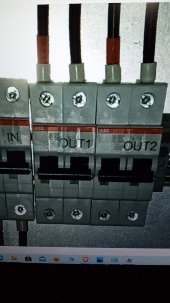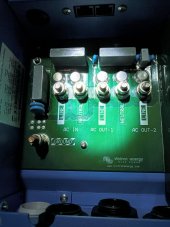Lighten up Mike, you'll live longer. If you can't handler a little jovial banter, up your health insurance. It was an obvious JK.
I've seen things strung together across other countries that defies explanation. People use whatever they have to work with and whatever is lesser expensive that would raise a Western brow, let alone be anywhere near any sort of code.
Best case scenario is that he still needs a ground leg for the A/C and his Victron is the right model and output for his locale. Those two wires sticking up from the floor may be hot and neutral, but both of those wires look black to me in the pic.
On top of that they are wired to a standard zip cord plug, being hand twisted together and then soaked in insulating black tape goo. Temporary I'm sure.
@ Agro - I can see your obvious investment in your infra and need to get things tied together. It seems like the question is still this > "Which of the two black wires for your inverter are supposed to be Line and Neutral?" and also "How to ground the AC system along with my solar power system?"
Can you answer the questions for Hedges and provide any sort of schematic of these systems and how they are supposed to interconnect?
Can you provide more pics of the system end to end from your solar system through the breakers in your box and to any outlets? Did the electrician install a physical ground rod and are there any green wires or grounds other than your solar system?
Almost.
For the first question I'm asking about the black wire and the blue wire coming from the floor of the house. I already know the inverter AC wires. They were labelled properly. The black wire and blue wire from the floor do not have a label, and the color scheme was not explained to me. That's my first question: Which of the house wires (the ones coming from the floor) is Line (Hot) and which is Neutral? I was told it doesn't matter which is which.
Yes. That is my second question.
Keep in mind, not to sound too harsh, it's possible this electrician is half-retarded, and doesn't remember how he wired the house. We did already confirm with a generator though, that the house works. The light switches turn on the lights and every outlet ran our blender that we used to test.
So, the electrician should've grounded the AC side of things? I made it clear from the start that we would be installing a grounding electrode, so please let me know if the AC side of things needs to have some sort of ground-wire coming out of the floor in addition to the black and blue wires that are already present.
Can you answer the questions for Hedges and provide any sort of schematic of these systems and how they are supposed to interconnect?
I'm confident in my solar install. I'm not worried about that. It's the AC side of things that has me worried. I've had too many people do crappy work down here, so I'm very suspicious. Yes, the solar is a huge investment.
So the AC side should have a grounding point at the main circuit breaker box for the house? I'm not sure the electrician left any way to ground anything at the circuit breakers. All my DC (solar is grounded properly, so not worried about that side of things.)
Is grounding the AC something that can be done "after the fact" or is it too late?









